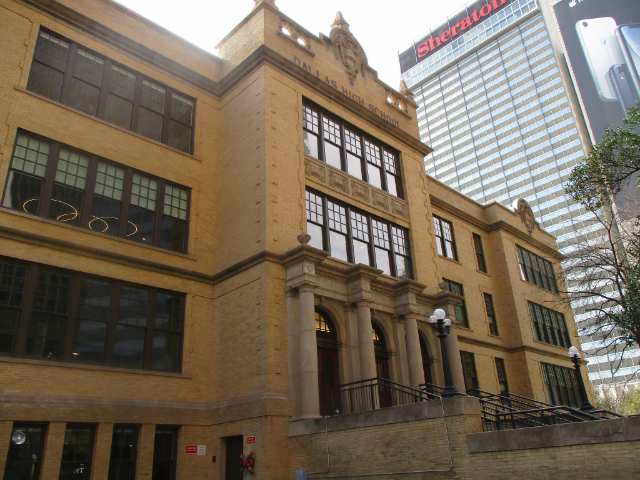DALLAS, TX – What happens when you spot a preservation-worthy building and know the owner is bent on demolition and utterly resistant to the idea of a landmark designation?
Last week I broke down landmarking your residence. For commercial buildings, though? Well, that’s where it gets tricky.
Developers in Dallas are not always homegrown, so they often don’t understand why a building is significant, or they choose to ignore its historic importance in favor of profit.
Let’s take a couple of examples.
The 1907 Classical Revival Dallas High School faced the most significant amount of resistance we’ve seen in Dallas, ending up in a lawsuit against the city that was decided favorably for preservation in the Texas Supreme Court.
If you purchase a building, shouldn’t you be allowed to what you want? Not necessarily. The Dallas High School was designed by noted architects Lang and Witchell and is one of the few non-residential links to our past.
The landmark nomination form included the following information:
The Dallas High School, later known as Nathan Robert Crozier Technical High School, complex at Bryan and Pearl Street is one of the most prominent landmarks in the city. The Auditorium and Classroom Building opened on this site in 1908, replacing late 19th century buildings. From 1907 to 1954, the period of significance, the Dallas Independent School District added four more buildings on the site and operated under seven different names. The Dallas High School complex meets Criterion A in the area of education at the local level as one of the oldest intact educational facilities in Dallas. This historic district constitutes the only intact complex that reflects the evolution of vocational training theories and practice at the secondary level in Dallas. Dallas High School complex are some of the oldest institutional buildings on the local school district property roles and remained in continuous use until September 1995. All five buildings are contributing to the site.
Although this was quite the battle, the building was landmarked over the owner’s objections and eventually sold to a developer that successfully turned it into office space.
St. Ann’s School is another example of a building landmarked over owner objections.
Built in 1927, it was the first school for Hispanic children in Dallas and owned by the Catholic Diocese. As the Little Mexico neighborhood gradually disappeared, it no longer served a purpose and was cost-prohibitive to maintain. The church wanted to tear it down and sell it for land value. The cultural value was deemed far too significant for demolition, and the building was saved.
Getting Owners to See The Light
We have many instances of owners not being on board with preservation. In many cases, once they understand the history and importance of a building and potential tax credits, they see the benefits.
So how do you start the process if you have information about a building and know it’s in danger? I rang up Liz Casso, a senior planner with the city’s Office of Historic Preservation, for some answers.
“The Landmark Commissioner is your best bet,” she said. “It’s helpful if the interested person has done the legwork and includes the history of the property. If it meets at least three of our ten criteria for consideration, it’s put on the agenda of the commission and will start the discussion.”
This can be a process. If you are not up for it, there is always the option of hiring a historic preservation researcher that understands the requirements and is adept at filling out the landmark nomination forms.
While a non-owner can bring information to the commissioner, they cannot initiate a property for designation.
“The property owner, the Landmark Commission, the City Plan Commission, or the City Council can bring up a designation for discussion,” Casso said.
Once a building has been put on the agenda and discussed, it allows the Landmark Commission to reach out to owners that may be resistant.
“There are a lot of instances where owners have not thought about it, and they do care, but they just don’t know about the tax credits and how to go about getting a designation,” Casso said. “For instance, the City Plan Commission initiated designation of the Belmont Hotel, and the owner is excited about it.”
There is a caveat here. If an owner is set on demolition and the wheels are in motion, there’s not really a way to save a building. A case in point is El Corazon restaurant in Oak Cliff.
“Everyone loved this restaurant,” Casso said. “However, the owners wanted to tear it down and sell the land. The project was in motion, but the Landmark Commission initiated protection. We had a conversation, and it was complex. In the end, we cannot rescind steps already taken, and now there is a CVS where El Corazon once stood.”
You win some. You lose some.
And some are a draw, like the DISD administration building on Ross Avenue. I know I held my breath when demolition began there. The owner changed initial plans after a discussion with the Landmark Commission and retained part of the façade.
The City Council has the final word. They have the ultimate authority to deem a property architecturally and culturally significant and can designate over objections.
If you have a keen interest in saving a building, do as much research as possible. You can email Ms. Casso for details. Once you have your research together, contact your Landmark Commissioner and get the ball rolling. Here’s the process in a nutshell:
- Check The website or email Ana ( Liz) Casso
- Research the property history.
- Contact the Landmark Commissioner for your district.
- If the Commissioner is agreeable they will contact Office of Historic Preservation Staff to place the item on a Landmark Commission meeting agenda for discussion.
- If the Landmark Commission believes the property may be eligible for designation they will vote to move forward with the initiation process. This does not mean the property is designated yet or ultimately will be.
- Once initiated, there is a two-year window in which to complete the process. During that time Staff would work with the owner to see if they are agreeable to the designation. A draft nomination report and draft preservation criteria would be created. The nomination report documents the history of the property and involves a lot of historical research. The preservation criteria are the preservation rules that will apply to the property if designated. Both documents are vetted through the Designation Committee of the Landmark Commission.
- Once the draft report and criteria have been developed, the item would be put back on a Landmark Commission meeting agenda for consideration of actual designation. They make a recommendation on the designation for Council.
- The City Plan Commission is the next step. They will make a recommendation on the designation for Council.
- City Council is the ultimate deciding body.
Note: If the property owner continues to strongly object to the designation it would require a ¾ vote in the affirmative from all three bodies for the designation to go through.






